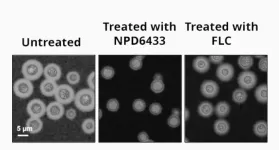(Press-News.org)
A new study from UC San Diego Scripps Institution of Oceanography researcher emeritus Peter Bromirski uses nearly a century of data to show that the average heights of winter waves along the California coast have increased as climate change has heated up the planet.
The study, published today in the Journal of Geophysical Research - Oceans, achieved its extraordinarily long time series by using seismic records dating back to 1931 to infer wave height, a unique but accepted method first developed by Bromirski in 1999. The results, made more robust by their 90 years of statistical power, join a growing body of research that suggests storm activity in the North Pacific Ocean has increased under climate change.
If global warming accelerates, growing winter wave heights could have significant implications for flooding and erosion along California’s coast, which is already threatened by accelerating sea-level rise.
When waves reach shallow coastal waters, some of their energy is reflected back out to sea, Bromirski said. When this reflected wave energy collides with waves approaching the shoreline, their interaction creates a downward pressure signal that is converted into seismic energy at the seafloor. This seismic energy travels inland in the form of seismic waves that can be detected by seismographs. The strength of this seismic signal is directly related to wave height, which allowed him to calculate one from the other.
In using this relationship to infer wave height, Bromirski had to filter out the “noise” of actual earthquakes, which he said is easier than it sounds because earthquakes are typically much shorter in duration than the ocean waves caused by storms.
Bromirski developed this novel way to calculate wave heights out of necessity. Seeing patterns or trends in phenomena such as storm activity or big wave events associated with climate change requires many decades of data, and the buoys that directly measure wave heights along the California coast have only been collecting data since around 1980. Of particular interest to Bromirski were the decades prior to 1970 when global warming began a significant acceleration. If he could get his hands on wave records stretching back several decades before 1970, then he could assess the potential influence of climate change.
Since no direct wave measurements going back that far existed, Bromirski began a search for alternative sources of data in the 1990s. In 1999, he published a paper detailing his method of deriving historic wave heights using modern digital seismic records. In the process, Bromirski learned that UC Berkeley had seismic records going back nearly 70 years at the time. The problem was that these records were all analog — just sheets and sheets of paper covered in the jagged lines of seismograph readings.
To work in the many decades of seismic records held at UC Berkeley to create a long-term wave record using this method, Bromirski needed to digitize the reams of analog seismograms spanning 1931 to 1992 so that he could analyze the dataset as a whole. The process required the enthusiasm of multiple undergraduate students, a special flatbed scanner, and multiple years of intermittent effort to complete.
Finally, with the digitized seismic data spanning 1931-2021 in hand, Bromirski was able to transform those data into wave heights and begin to look for patterns.
The analysis revealed that in the era beginning after 1970, California's average winter wave height has increased by 13% or about 0.3 meters (one foot) compared to average winter wave height between 1931 and 1969. Bromirski also found that between 1996 and 2016 there were about twice as many storm events that produced waves greater than four meters (13 feet) in height along the California coast compared to the two decades spanning 1949 to 1969.
“After 1970, there is a consistently higher rate of large wave events,” said Bromirski. “It’s not uncommon to have a winter with high wave activity, but those winters occurred less frequently prior to 1970. Now, there are few winters with particularly low wave activity. And the fact that this change coincides with the acceleration of global warming near 1970 is consistent with increased storm activity over the North Pacific resulting from climate change.”
The results echo an increase in wave height in the North Atlantic tied to global warming reported by a 2000 study.
If California’s average winter waves continue to get bigger under climate change, it could amplify the effects of sea-level rise and have significant coastal impacts.
“Waves ride on top of the sea level, which is rising due to climate change,” said Bromirski. “When sea levels are elevated even further during storms, more wave energy can potentially reach vulnerable sea cliffs, flood low-lying regions, or damage coastal infrastructure.”
To see how his results compared with atmospheric patterns over the North Pacific, which typically supplies the California coast with its winter storms and waves, Bromirski looked to see if a semi-permanent wintertime low pressure system located near Alaska’s Aleutian Islands called the Aleutian Low had intensified in the modern era. A more pronounced Aleutian Low typically corresponds to increased storm activity and intensity.
Per the study, the intensity of the Aleutian Low has generally increased since 1970. “That intensification is a good confirmation that what we are seeing in the wave record derived from seismic data is consistent with increased storm activity,” said Bromirski. “If Pacific storms and the waves they produce keep intensifying as climate change progresses and sea-level rises, it creates a new dimension that needs to be considered in terms of trying to anticipate coastal impacts in California.”
END
With mighty jaws and plate-like teeth, the whitespotted eagle ray (Aetobatus narinari) can pretty much crunch on anything. In fact, hard clam farmers in Florida’s Indian River Lagoon have considered this species a threat to their production efforts and profit margin. This assumption, however, is mostly anecdotal.
Despite their protected status in Florida and designation as globally “endangered,” there is limited information in the United States available on critical components of the life history of the whitespotted eagle ray, such as their diet. Prior observations have described a location-specific yet variable diet consisting of hard ...
COLUMBUS, Ohio – More than 4 out of 5 older women survivors of colorectal cancer may be experiencing a range of gastrointestinal symptoms many years after being diagnosed and treated, a new study suggests.
Using data from the Women’s Health Initiative, researchers found that 81% of colorectal cancer survivors reported persistent GI symptoms, with abdominal bloating and gas topping the list as the most common and severe problem. The average time since diagnosis was eight years for all participants whose data was used in the study.
The analysis also showed that severe GI symptoms were linked to poor quality of life, ...
Just a handful of years ago, retinoblastoma had the medical field stumped. This pediatric eye cancer cannot be directly biopsied, which means clinicians must diagnose the disease by visual examination and imaging. Recently, a researcher at Children’s Hospital Los Angeles developed a new way to diagnose retinoblastoma by sampling the fluid at the front of the eye. These liquid biopsies also offer genetic and chromosomal information, which gives a more complete picture of each child’s disease. Now CHLA will lead an international liquid biopsy retinoblastoma study, the first of its kind.
A New Line of Research
Jesse Berry, MD, is the Director of Ocular Oncology ...
Climate change goals set out in the Paris Agreement are only economically reasonable if non-market factors such as human health and loss of biodiversity are prioritised, according to a new study published by Dr Taikan Oki, former Senior Vice-Rector of United Nations University headquartered in Japan, in IOP Publishing’s academic journal Environmental Research Letters.
A multi-disciplinary, collaborative effort from researchers at 23 institutions including The University of Tokyo, National Institute for Environmental Studies, and Kyoto University, the new study provides a cost-benefit analysis ...
Only 19% of Saudi Arabian women are diagnosed at stage I of cervical cancer where survival rates are highest, according to a study published by the King Abdulaziz University. To further motivate action to combat cervical cancer, BGI Genomics today released its State of Cervical Cancer Awareness Report in Saudi Arabia. This report assesses the level of knowledge, attitudes, and practices related to cervical cancer screening and HPV vaccination. By examining these key areas, this survey seeks to highlight the associated barriers and opportunities. 1,878 female respondents from six countries ...
Smoking in pregnancy can harm developing babies, especially their growth . Current guidelines recommend that pregnant smokers who find quitting difficult should be provided with nicotine replacements products and stop-smoking services usually recommend nicotine patches.
This research published in NIHR Journals Library, suggests that pregnant women should also consider e-cigarettes.
The study included 1,140 pregnant women who were trying to stop smoking who were divided into two groups. Half of the women received e-cigarettes; the other half received nicotine patches. Both approaches were equally safe. The only meaningful difference was that fewer ...
A group of international researchers has achieved a breakthrough in computer security with the development of a new and highly efficient cipher for cache randomization. The innovative cipher, designed by Assistant Professor Rei Ueno from the Research Institute of Electrical Communication at Tohoku University, addresses the threat of cache side-channel attacks, offering enhanced security and exceptional performance.
Cache side-channel attacks pose a significant threat to modern computer systems, as they can stealthily extract sensitive information, including secret keys and passwords, from unsuspecting victims. ...
WASHINGTON — People with type-II diabetes who drank the fermented tea drink kombucha for four weeks had lower fasting blood glucose levels compared to when they consumed a similar-tasting placebo beverage, according to results from a clinical trial conducted by researchers at Georgetown University's School of Health, the University of Nebraska-Lincoln and MedStar Health. This finding, from a pilot 12-person feasibility trial, points to the potential for a dietary intervention that could help lower blood sugar levels in people ...
Researchers at the RIKEN Center for Sustainable Research Science (CSRS) and the University of Toronto have discovered a new way to attack fungal infections. The key is to block fungi from being able to make fatty acids, the major component of fats. Resistance to anti-fungal drugs is increasing and this new approach will be particularly useful because it works in a new way and affects a broad range of fungal species. The study was published in the scientific journal Cell Chemical Biology.
Most of us are familiar with athlete’s ...
Only 28.5% of Thai women are diagnosed at stage I of cervical cancer when survival rates are highest, according to a study published by the Mahidol University. To further motivate action to combat cervical cancer, BGI Genomics released its State of Cervical Cancer Awareness Report in Thailand. This report assesses the level of knowledge, attitudes, and practices related to cervical cancer screening and HPV vaccination to highlight the associated barriers and opportunities. 1,878 female respondents from six countries and ...






